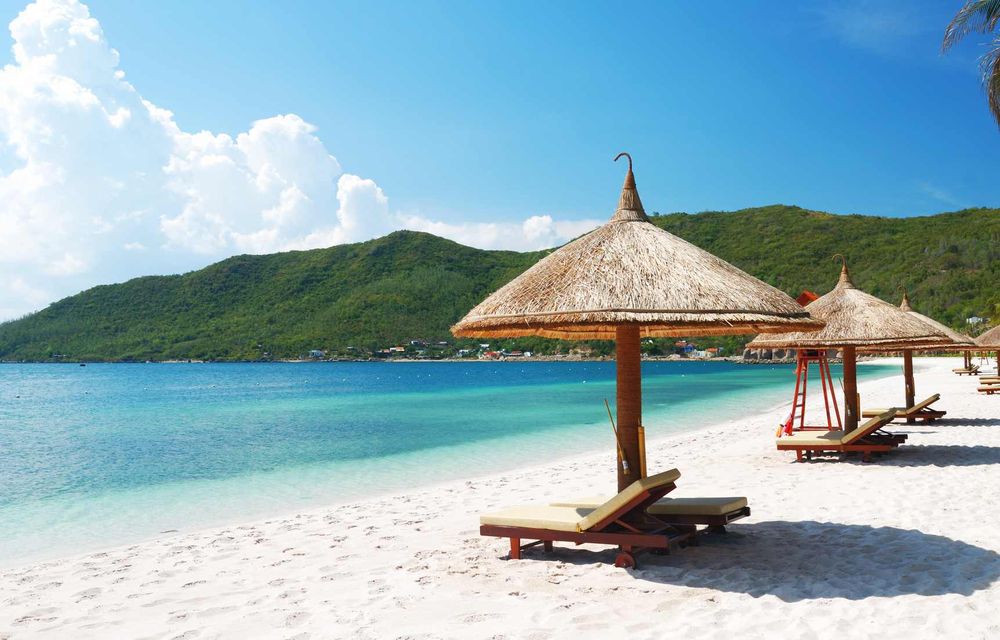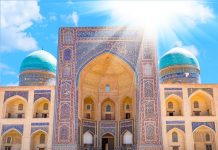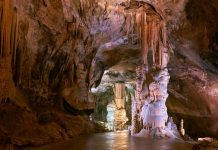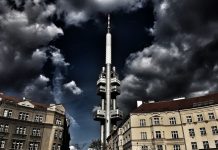MAGELLAN MARKER, Punta Engaño, Lapu-Lapu City about 20 kms. from Cebu City. Encouraged by the success of Christianizing the people of Cebu, Magellan crossed the channel to Mactan Island in an effort to spread the faith. Before he reached the shores, he was killed by the chieftain of the island, Lapulapu and his men during the battle for supremacy and freedom on April 27, 1521. Efforts to retrieve the body of Magellan were futile in spite of the offer to trade jewelries and spices for his dead body. This marker was erected in 1866 to mark the spot where the great explorer died.
MAGELLAN’S CROSS, Magellan St. – Planted in April 14, 1521 by Ferdinand Magellan, this marks the spot where the first Christian Filipinos, Rajah Humabon and Queen Juana and about 400 followers were baptized by Fr. Pedro Valderama. In 1525 to 1740, the Agustinian priests built an open shrine for the cross, but the natives began to take chips from the cross believing it had miraculous power, so a kiosk destruction took place. To protect it further, a hollow cross of tindalo wood was made to encase the original cross which still stands today.
FORT SAN PEDRO, Pier Area, Cebu City – The smallest, oldest tri-bastion fort in the country. This served as the nucleus of the first Spanish settlement in the Philippines. It has a total inside area of 2,025 sq. meters. The walls are 20 feet high, 8 feet thick and towers are 30 feet high from the ground level. Work first started on May 8, 1565 with MIGUEL LOPEZ DE Legaspi breaking the ground. After the battle of Manila Bay, Commodore George Dewey turned the forth to the local Cebuanos; then it became an American Warwick Barracks during the American Regime which was later converted into classrooms where the Cebuanos received formal education.
During World War II, from 1941 to 1945, it served as fortification for Japanese soldier, when the battle for liberation was fought, the fort served as an army cam. After 1950, Cebu Garden Club took over and fixed the inner court into a miniature garden. For a couple of years it also housed the Cebu City Zoo. In 1978 to August 15, 1993, it housed the offices of the Department of Tourism and the Philippine Tourism Authority. At present, it is under the care and administration of the National Museum.
LAPU-LAPU MONUMENT, Punta Engaño, Lapu-Lapu City – Site where the battle between Mactan Island Chieftain Lapu-Lapu and the foreign aggressor Ferdinand Magellan occurred in April 27, 1521. It depicts the hero holding a bolo in one hand and a pestle on the other. Said weapons were believed to have been used during his combat with Magellan. This monument stands as a reminder of Filipino bravery.
UNIVERSITY OF SAN CARLOS, P. Del Rosario St., Cebu City – The oldest school in the country established in 1565. This was formerly called Colegio de San Ildefonso established by the Jesuits.
COLON STREET, Downtown Area, Cebu City – This is also known as Parian District, the oldest street in the Philippines built by the Spaniards during the time of Miguel Lopez de Legaspi. Named after Christopher Columbus, it is the heart of downtown Cebu, a glittering city by night lined with movie houses, restaurants, department stores, and other business establishments.
CAPITOL BUILDING, Osmeña Blvd., Cebu City – The seat of the Provincial government, is of pre-war vintage and has the undulating mountains of Cebu for its background. Majestic and imposing, its high dome can be seen along Osmeña Boulevard. A replica of the United States’ White House. One of the many beautiful capitol buildings in the country, constructed in 1937 under the administration of Governor Sotero Cabahug.
CASA GORORDO MUSEUM, 35 Lopez Jaena St., Cebu City – Located in Lopez Jaena Street, is the home of the first Filipino Bishop of Cebu. A tour inside this residence is a brief journey into a Filipino lifestyle in a particular period between 1860 to 1920. The place presently features noted paintings, museum relics, a courtyard, antique household items and furniture.
Open from 9:00 a.m. to 12:00 nn and 1:00 p.m. to 5:30 p.m., Monday to Saturday. Admission fee for adults is PHP 15.00 and 5.00 for children.
FORT SAN PEDRO NATIONAL MUSEUM, Legaspi Ext., Cebu City – A product of years of research, the collection in view are anthropological and biological. The anthropological section portrays the cultural development and influence into society and its close affinity with the people of South East Asia. The biological section presents samples of the flora and fauna of the country in general and Cebu in particular.
Admission fee PHP 5.00 per person; open Monday thru Friday from 8:00 am to 12:00 nn and 1:30 pm to 5:30 pm; Saturday from 8:00 am to 12 nn only.
CULTURAL
THE SOUTHWESTERN UNIVERSITY MUSEUM, Urgello Private Road, Cebu City – It gives a quick look of Cebuano art and lifestyle, from the prehistoric to Hispanic times. Also in this room are burial jars, boat coffins, death masks in gold, trade pottery (from China, Cambodia and Vietnam, including Ming, Celadon and other China trade jars, as well as Ben Chieng and Haripunchai pottery), gold teeth peggings (the design of the decoration showed where its owner came from, whether from Cebu or Leyte of Bohol, or whatever), excavated trade beads and heirloom jewelry, santoses and church carvings and other church accessories. The museum is open to the public from 10:00 am to 12:00 nn, and 1:00 pm to 5:00 pm from Tuesday to Saturday while the Filipiniana Research Center is open from Monday to Saturday from 7:00 am to 7:00 pm.
JUMALON’S FAMILY CULTURAL PROJECT, 20 Macopa St., Basak, Pardo, Cebu City – A LEPIDO MOSAIC ART collection, so called because it utilizes butterfly wings as its medium. Beautiful and intricate samples of these artworks can be seen at PROF. JULIAN JAMALON residence at 20 Macopa St., Basak, Pardo, Cebu City. No admission fee.
RIZAL MUSEUM AND LIBRARY, Osmeña Blvd., Cebu City – Located within Cebu City Library along Osmeña Boulevard showcases a collection of antiques donated by famous and rich Cebuano families. Also on display is a collection of artworks of Cebuano painters and artists. Its upper floor is the Rizal Memorial Library which keeps some important books on Cebuano history and culture.
AZNAR-ALFONSO ANTIQUE COLLECTION– Owned by Dr. Lydia Aznar-Alfonso, the antique collection is of much younger vintage. Pieces of lovely period furniture, a very wide collection of antique jewelry. santoses as well as authentic grave goods from various archaeological diggings in the island of Mactan and Cebu helped enrich Dr. Alfonso’s beautiful collection.
ARCENAS ANTIQUE COLLECTION– Spanish period furniture and santoses, jewelries, pottery, porcelain wares are on display at Dr. and Mrs. Ramon Arcenas residence located at Banawa, Cebu City.
ROSE ONG ORCHID COLLECTION– So beautiful and varied, the biggest orchid collection in the province.
PRES. SERGIO OSMEÑA MEMORABILIA– Contains the late president’s historic car, his personal belongings and mementos.
RIZALIANA MUSEUM– Contains the memorabilia of Dr. Jose Rizal given by his sister to the University of Southern Philippines Museum.
SALA PIANO MUSEUM, Gorordo Avenue, Lahug, Cebu City – A unique collection of hundreds of pianos of varying sizes and shapes. Venue to classical concerts and houses a music foundation. Open from 9:00 am to 12:00 nn; afternoons by appointment. Admission fee PHP 5.00 for adults and PHP 1.00 for children.
NATURAL
MACTAN ISLAND– A coral island and famous for scuba diving, where beach resorts of international standards are located. Also the site of the Export Processing Zone I, with 100 companies in operation, employing 36,575 people with a monthly payroll of P226 million. Land area – 150 has.
MOALBOAL, South of Cebu – Located 89 kms. southwest of Cebu City, famous for beautiful corals and reefs, white sandy beaches, excellent for diving. Accommodation is offered by the Badian Beach Resort, a AAA class resort.
BADIAN ISLAND. It was on Christmas day when the Spaniards reached the island. According to townfolks, it was supposed to be a special day of celebration but unfortunately a storm hit the island and so came the name MALAPASCUA, MALAS SA PASKO, which means Unfortunate Christmas in English. Malapascua is sometimes referred to as LOGON, the main community in the south. Logon got its name when the Japanese and Spaniards fought over the island during the World War II.
The island is 3 kms. long and 1 km. wide, with a population of about 3,000. It has white sand beaches and crystal clear waters. The west coast is ideal for swimming and snorkeling but one should be careful because of unpredictable weather. A walk or tour on the whole island can be done for about two hours.
CAMOTES ISLAND. The island is located at the northeast of Cebu province and is composed of 4 towns, namely: Poro (composed of 17 barangays), San Francisco (composed of 15 barangays), Tudela (composed of 8 barangays), and Pilar (composed of 5 barangays). To cross the island, one has to go to Danao City, an hour away from Cebu City or take a fast ferry. There are two boats which travel to and from the island and Danao City everyday, one fastcraft which travels twice a day and a regular boat thrice a week. Travel to and from the island is around 2 hours and mode of transportation within the island are motorcycles.
KAWASAN FALLS– Located in Badian, one can feel the coolness of the surrounding lush greenery of this panoramic waterfalls. Accommodation from cheap to moderate rates are available.
NONOC CAVE– Located in Borbon, 8 kms. north of Cebu City, a very picturesque shelter for picnickers and bathers.
OLANGO WILDLIFE SANCTUARY– Olango Island supports the largest concentration of migratory birds found so far in the country. Migration starts from the breeding places of birds in Siberia, Northern China and Japan. Anticipating the scarcity of food and winter cold, these birds fly as far as Australia and New Zealand from late July until late November. This is usually referred to as the Southward Migration. By late February until May, these birds return to their breeding grounds in the reverse Northward Migration.
Based on data gathered so far, the birds use Olango as a major refueling station as well as a wintering ground. At Olango, the birds can replenish their fat reserves by feeding on rich supply of invertebrates in the intertidal mudflats. These fat reserves must fuel birds on the next lap of their journey which may cover from 3,000 to 15,000 km. of non-stop flight. Land Area-1,022,6228 has.
RELIGIOUS
Image of Santo Niño– Considered as the oldest religious relic in the Philippines. It was on April 14, 1521 that Magellan gave the image to Queen Juana as a baptismal gift. Forty-four years later, on April 27, 1565 when Miguel Lopez de Legaspi arrived, Fr. Andres de Urdaneta who formally christianized the Cebuanos, found the natives hostile. Legaspi besieged the settlement and set the village on fire. It was on one burnt houses that Juan Camus, a soldier, found the image of Sto. Niño unscratched. Since then, the miraculous image has been venerated by the Cebuanos as its patron saint. At present, the miraculous image is kept in the parish convent, and a replica is adorned with gold and precious stones and enshrined in glass. It is housed in a side altar inside the Basilica Minor del Santo Niño.
BASILICA MINOR DEL SANTO NIÑO– This church was built by Miguel Lopez de Legaspi and Fr. Andres Urdaneta on the site where the image of Santo Niño was found in 1565. The first structure of the church was, however, destroyed by fire on November 1, 1568. It was rebuilt in 1602 under the administration of Juan Albaran and was rehabilitated in 1740. On May 1965, the church was conferred the title of Basilica Minor del Santo Niño by Cardinal Antonuitte, Papal Legate during the Fourth Centennial celebration of the Christianization of Cebu.
MANDAUE-MACTAN BRIDGE– Built in 1972 at a cost of P 65 million. This 864-meter bridge connects the islands of Mactan and Cebu.
TOPS– Situated on top of cool Busay Hills, an excellent sight seeing spot which offers a breathtaking view of Metro Cebu and the islands of Mactan and Olanga. Cottages are available for daytime picnics and instant evening parties.
PARADISE VALLEY– Located in Paril, Barili, 61 km. south of Cebu City. Take off for a perfect weekend and simply bask in the awesome and natural splendor of Cebu’s only Mountain Resort. Only 90 minutes drive away from the city life, passing through scenic and picturesque terrain and seaside towns of the south.
BEVERLY HILLS– A scenic subdivision on Lahug Hills commands a breathtaking view of the entire city.
LILOAN LIGHTHOUSE– Found in the municipality of Liloan, around 18 kms. north of Cebu City. Built by the Americans in 1904.
THE NEW CEBU COLISEUM– A sports center located at Sanciangco Street where concerts and ball games are usually held.
YMCA– Along Osmeña Blvd. is a sports complex equipped with body building equipment, swimming pool, bowling lanes and ball game courts. Accommodation is also available.
TOURIST ATTRACTIONS – MAN-MADE
ST. CATHERINE’S SCHOOL– In Carcar, Cebu. Founded in 1923
EMERGENCY HOSPITAL AND DISPENSARY– In Carcar, Cebu
SPANISH-ERA TOWN RESIDENCE– In Argao, Cebu
BALUARTES OR WATCHTOWERS– In Oslob, Cebu.
CEBU CITY YOUTH AND SPORTS COMPLEX– Located at Abellana National School grounds, was constructed for the 1994 Palarong Pambansa. The sport complex is considered the country’s best today. It boasts of the following facilities: 2 grandstands which can accommodate 15,000 people, Olympic size swimming pool, rubberized oval, baseball field, and quarters for athletes and officials.
CEBU GOLF AND COUNTRY CLUB– An 18-hole golf course located in Banilad, Cebu City.
FUENTE OSMEÑA– A lovely circular park with a beautiful fountain in the middle. Named after Cebu’s Grand Old Man, the late President Sergio Osmeña, Sr.












